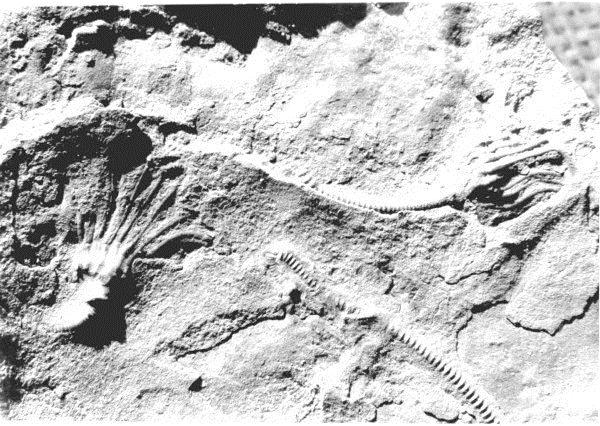Crinoid
Invasion

Crinoids are marine animals
which live in both shallow water and depths of up to 6000
meters. Crinoids are characterized by a mouth on the top
surface that is surrounded by feeding arms. They have a U-shaped
gut, and their anus is located next to the mouth. Although the
basic echinoderm pattern of fivefold symmetry can be recognized,
most crinoids have many more than five arms. Crinoids usually have
a stem used to attach themselves to sediments at the bottom of
streams, but many live attached only as juveniles and become
free-swimming as adults. There are only a few hundred known modern
forms of crinoids, however they were much more numerous both in
species and numbers in the past. Some thick limestone beds dating
to the mid- to late-Paleozoic era are almost entirely made up of
distinct crinoid fragments. At this location you will prominently
find an abundant concentration of crinoid stems imbedded throughout
the limestone.

Samples of smaller crinoid stem segments
Crinoids comprise three basic sections; the stem,
the calyx, and the arms. The stem is composed of highly porous
ossicles which are connected by ligamentary tissue. The calyx
contains the crinoid's digestive and reproductive organs, and the
mouth is located at the top of the dorsal cup, while the anus is
located peripheral to it. The arms display pentamerism or
pentaradial symmetry and comprise smaller ossicles than the stem
and are equipped with cirri which facilitate feeding by moving the
organic media down the arm and into the mouth.

Crinoids feed by filtering small particles of food from the sea
water with their feather like arms. The tube feet are covered with
a sticky mucus that traps any food that floats past. Once they have
caught a particle of food, the tube feet can flick it into the
ambulacral groove, where the cilia are able to propel the stream of
mucus towards the mouth. Generally speaking, crinoids living in
environments with relatively little plankton have longer and more
highly branched arms than those living in rich environments.
Crinoids have separate male and female individuals. They produce
their gametes from genital canals found inside some of the
pinnules. The pinnules eventually rupture to release the sperm and
eggs into the surrounding sea water. The fertilised eggs hatch to
release a free-swimming larva. The larva is barrel-shaped with
rings of cilia running round the body, and a tuft of sensory hairs
at the upper pole. In some cases females have been known to
temporarily brood the larvae using chambers within the arms. The
larva does not feed, and lasts only for a few days before settling
to the bottom and attaching itself to the underlying surface using
an adhesive gland on its ventral surface. The larva then
metamorphoses into a stalked adult, with the adult eventually
breaking away from the stalk. Within 10 to 16 months the crinoid
will be able to reproduce.

Modern day Crinoid
In some areas, these crinoid stems are collected by either
extracting them from limestone or from the seashores and made into
necklaces and rosaries. These are commonly known in different
regions as St. Cuthbert's beads (England) and Indian beads
(Mid-west USA).
Crinoids are the state fossil of Missouri.
In order to log this ache
you will need to perform the following tasks and email me the
answers.
a) Count how many crinoid stems are present
on the surface area of the limestone.
b) What is the length of the largest of these crinoid stem
fossils?
c) Are there any crinoid fossils present that show more than just
the stem of the crinoids? If yes, describe and indicate how many
arms they have.
d) Select three prominent stems and calculate how many ridges per
inch are present in each. Is you answer the same, why or why
not?
We hope that you enjoyed learning about
crinoids and the next time you come across these fossils you will
have the knowledge to explain them to your friends.
This cache was placed under
direct supervision of park staff. Please use the provided trails
and visit this geocache only during park hours.